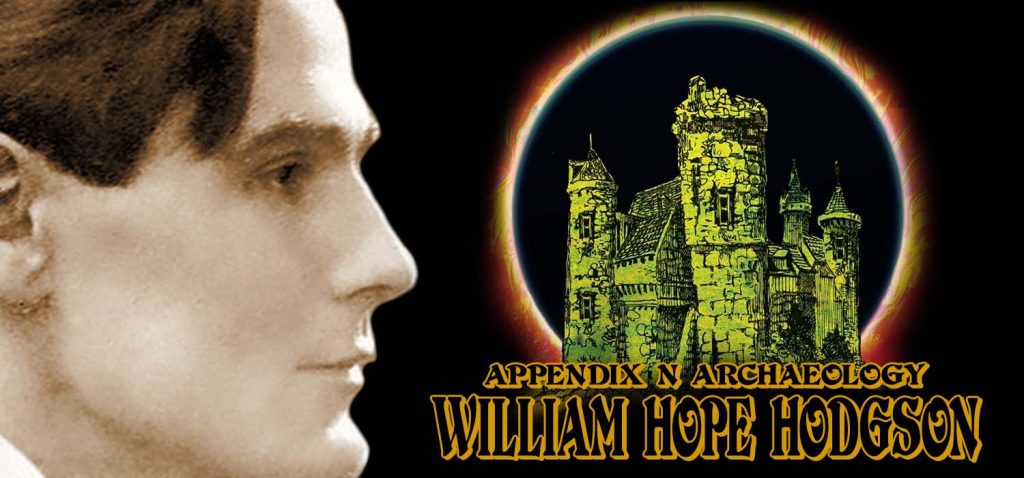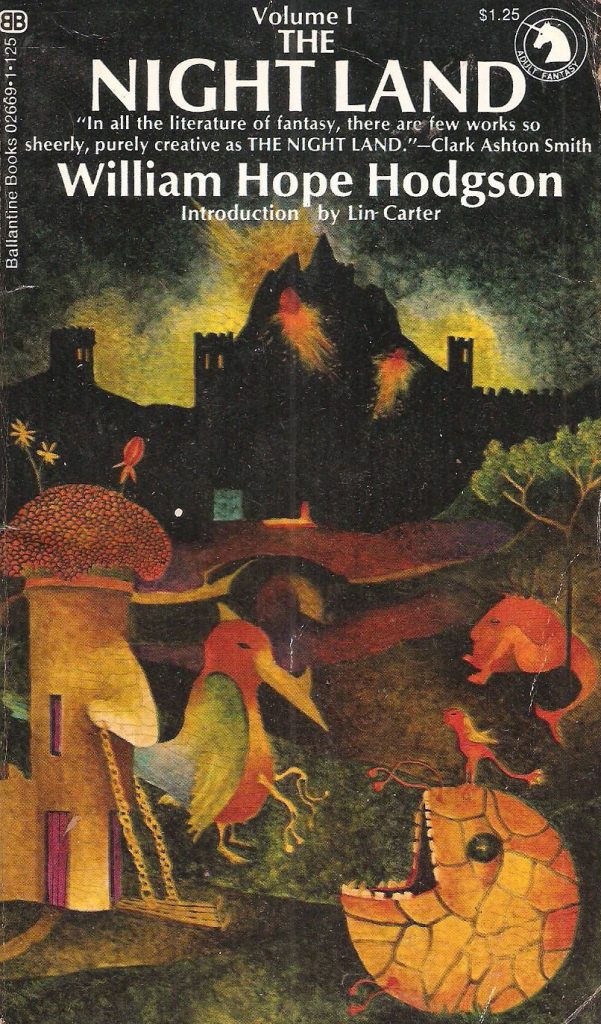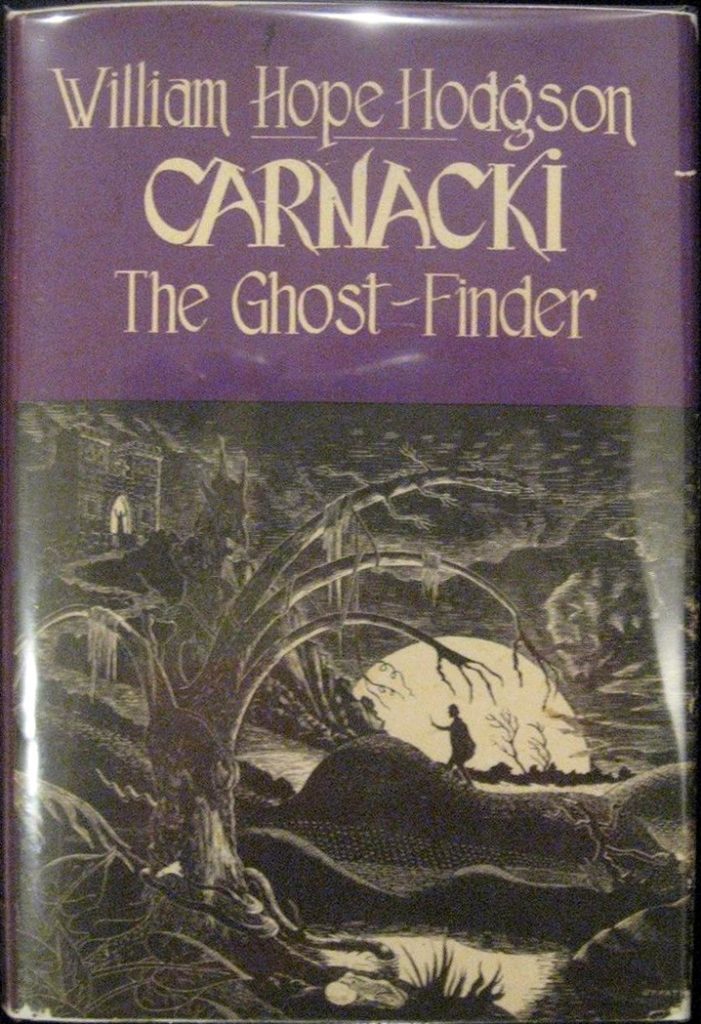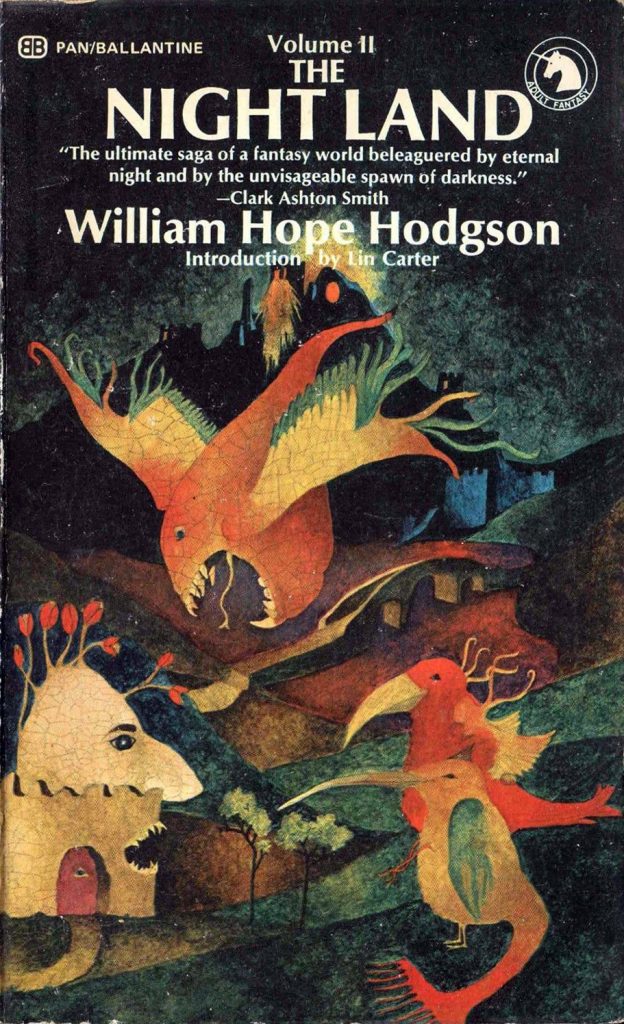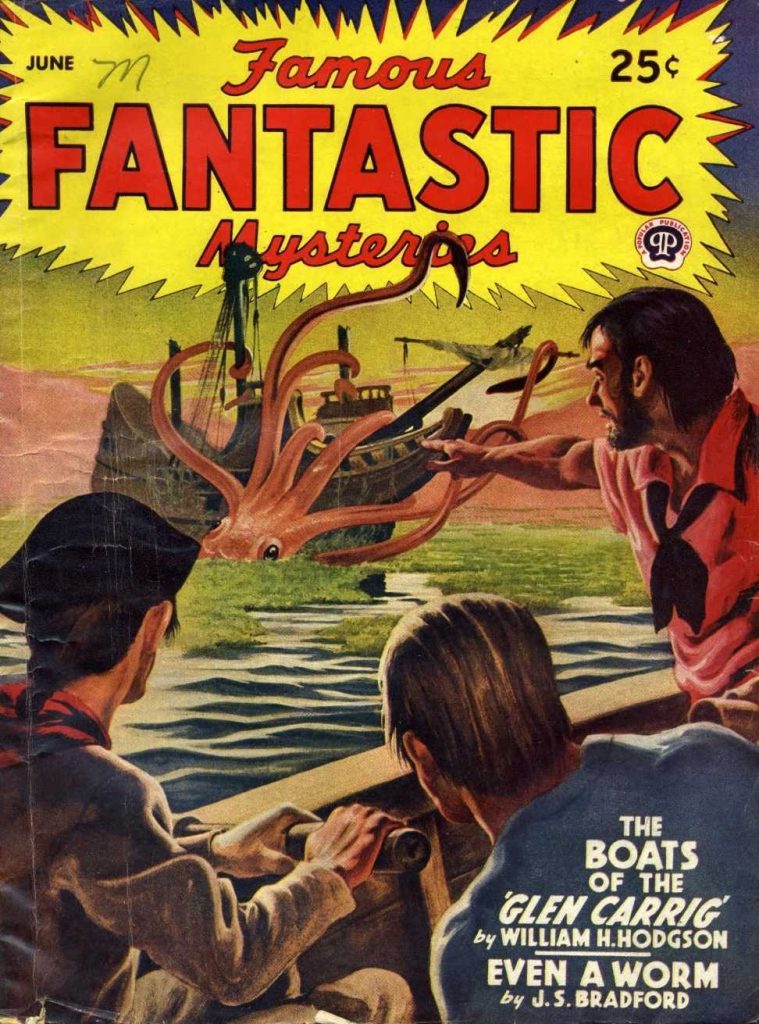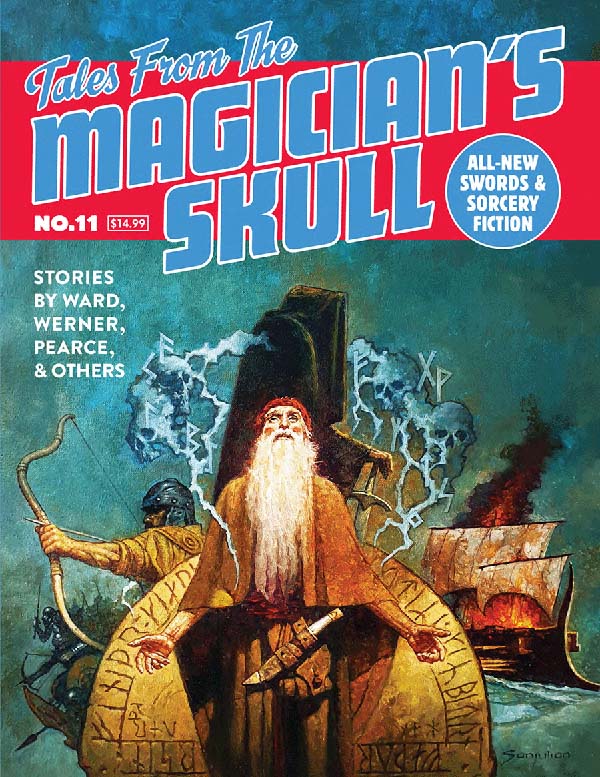Our Appendix N Archeology and Adventures in Fiction series are meant to take a look at the writers and creators behind the genre(s) that helped to forge not only our favorite hobby but our lives. We invite you to explore the entirety of the series on our Adventures In Fiction home page.
Appendix N Archeology: William Hope Hodgson
by Michael Curtis
In the now famed Appendix N, Gary Gygax lists roughly thirty authors whose works inspired the creation of Dungeons & Dragons. Many luminaries from the fields of both pulp sword & sorcery and horror fiction, as well as some then-current authors, fill that list. However, as with any catalog of inspirational sources, Appendix N is merely representative of what the cataloguer was immediately aware of. Each of the names appearing in Appendix N were in turn inspired by other authors, who were influenced by yet older writers. This long chain stretches far back into antiquity, terminating somewhere in the past when humanity still huddled around the fire and told stories of monsters lurking beyond the firelight.
The purpose of this series is to further excavate the Appendix N list, removing a layer or two to examine the writers who inspired Gygax’s picks. This exercise will hopefully not only give us greater insight into the central and nearly universal themes that thread their way through the “weird fiction” genre (the original name for works of fantasy and science fiction), but also expand the field with new authors aspiring judges and other game masters can draw upon for ideas or simple reading enjoyment.
We begin with a name that might not be familiar to all weird fiction fans but was certainly known by Gary Gygax—William Hope Hodgson. Hodgson was critically praised during his lifetime, but his works fell out of the public eye in the years following his death. Even today, Hodgson remains a peripheral figure to genre fans with few being familiar with his work.
William Hope Hodgson was born on November 15th, 1877 in Blackmore End in Essex, England, the son of an Anglican priest. Even at a young age, adventure called to Hodgson, and he ran away from boarding school in the hopes of becoming a sailor. Although this attempt was unsuccessful, Hodgson eventually received permission from his father to be apprenticed as a cabin boy in 1891, beginning his long career and association with the sea.
After several years as a sailor, during which he once saved a fellow sailor from shark-infested waters off the coast of New Zealand, Hodgson retired from the waves and opened an exercise school in 1899. Hodgson had developed an interest in body-building while at sea, where his small stature and boyish looks made him a target for bullying. Despite its popularity with the members of the local police force, Hodgson couldn’t earn a living from the school and cast about for new sources of income.
Inspired by the success of such contemporary authors as Edgar Allan Poe, H.G. Wells, Jules Verne, and Arthur Conan Doyle, Hodgson turned his attention to writing fiction and soon discovered he had a knack for it. His experiences at sea gave him a rich background of personal adventures to draw upon and his imagination embellished these events into enthralling tales.
Hodgson’s first accepted story, “The Goddess of Death,” published in 1904, was the tale of a stolen Hindu statue that comes to life and delivers revenge upon an English town. From the beginning, it was clear that Hodgson was at home in the “weird fiction” genre, although his works would ultimately include more prosaic subject matters and even poetry.
In 1906, an American magazine published “From a Tideless Sea,” the first story in what would become Hodgson’s “Sargasso Sea Stories.” This series of tales are all set around the Sargasso Sea, a seaweed-choked expanse of the Atlantic Ocean, where, in Hodgson’s fiction at least, ships become entrapped and their crews menaced by any manner of unnatural beasts that dwell in the morass of kelp. His first novel, The Boats of “Glen Carrig,” expands this theme to a picaresque story where the survivors of the shipwrecked Glen Carrig fight for survival in the Sargasso Sea, battling everything from giant crabs to humanoid monsters to giant octopi.
Hodgson wrote a number of other nautical-themed stories set outside of the Sargasso Sea. Some are in the weird fiction vein, such as “The Voice in the Night,” which was adapted into the gloriously colorful and outré Japanese film, Matango, but others were more humorous, like his stories of Captain Gault, a notorious smuggler who always manages to get one over on the custom agents opposing him.
But Hodgson was more than just an ex-sailor recounting fanciful, fictionalized accounts of his at-sea life: his tastes ran toward the occult and to science fiction as well. Among the most influential of Hodgson’s characters is Thomas Carnacki, also known as “Carnacki the Ghost-Finder.” Carnacki is an occult detective inspired by Sherlock Holmes and Sheridan Le Fanu’s Dr. Hesselius. Armed with his “electric pentacle,” Carnacki investigates cases with a supernatural bent, exorcising ghosts and tangling with the occasional non-supernatural agents behind these mysteries. As one of the earliest examples of the “occult detective” in fiction, Carnacki would help inspire a long litany of similar characters including Seabury Quinn’s Jules de Grandin, Manly Wade Wellman’s John Thunstone (and, to a lesser degree, John the Balladeer), Robert E. Howard’s Steve Harrison, Brian Lumley’s Titus Crow, Alan Moore’s John Constantine, and Jim Butcher’s Harry Dresden—to name just a few!
Hodgson wrote two novels after The Boats of “Glen Carrig” that delved into cosmic horror and science fiction themes. His second novel, The House on the Borderlands, begins in the Gothic vein but quickly exceeds the confines of that genre. It is the story of The Recluse, the owner of the aforenamed house, a domicile that exists as a portal between dimensions such as “the Plain of Silence” and the “Sea of Sleep,” home to horrific and bestial things. H.P. Lovecraft praised The House on the Borderlands as being “perhaps the greatest of all Mr. Hodgson’s works.” This is no small praise coming from the master of cosmic horror, himself.
His final novel, The Night Land, details a far-distant future Earth where the Sun has gone out and the world is lit only by dying volcanoes. The sole survivors of humanity dwell in a gargantuan metal pyramid and telepathy is a means of communication. The novel, a far cry from slimy sea monsters, impressed Clark Ashton Smith tremendously. Smith, known for his own prose poetry-like weird stories commented on The Night Land that “Only a great poet could have conceived and written this story.” Many have theorized that The Night Land was responsible for Smith’s own foray into the “Dying Earth” science fiction genre, inspiring his Zothique cycle of stories.
Tragically, Hodgson’s life and career were cut short at the age of 40. When World War I erupted, he and his wife, then living in France, fled back to England where Hodgson would eventually enlist for military service. Long disillusioned with the naval life, Hodgson became a lieutenant in the Royal Artillery. In 1918, Hodgson suffered an injury while on horseback and was discharged from service. However, after recovering from his injuries, he re-enlisted. This decision, albeit a patriotic one, was fatal: Hodgson was killed in an artillery barrage at the Fourth Battle of Ypres in 1918.
After Hodgson’s death, his widow continued to sell some of his completed works posthumously, but eventually his remaining works were depleted and, without new stories forthcoming, his name fell into obscurity. Hodgson might have remained forgotten had not the pulps of the 1930s enjoyed the popularity they experienced. A number of anthologies were published during this period to meet that popularity, works that collected other “weird fiction” to sell to the fans of the pulps. Two of these included Hodgson’s stories, bringing him to the attention of authors such as Lovecraft and Clark Ashton Smith for the first time. In later years, August Derleth’s Arkham House printed a Carnacki omnibus that included never-before-published tales of the occult detective.
Hodgson’s stories would never exert the inspirational gravitational force that some of his predecessors or contemporaries had upon the Appendix N authors, but they did have the occasional tidal pull that affected the course of another author’s writings. By the time his stories were anthologized in the 1930s, Lovecraft was approaching the end of his own career, his own untimely death gestating in his body. However, Lovecraft was so impressed by Hodgson’s stories that he wrote an essay on the man and his stories. This essay, “The Weird Work of William Hope Hodgson” was completed after Lovecraft’s in-depth exploration of weird fiction, “Supernatural Horror in Literature,” was finished, but the Providence-based writer later incorporated that essay into subsequent publications of “Supernatural Horror.” In his essay on Hodgson, Lovecraft calls him “second only to Algernon Blackwood,” and considering Lovecraft held the opinion that Blackwood’s “The Willows” was the greatest horror tale ever written, that’s no slight praise. Given Lovecraft’s abhorrence of the sea and sea life, it’s no wonder that the English author’s tales could send a shiver down old Uncle Theobald’s spine.
In a similar piece entitled “In Appreciation of William Hope Hodgson,” Clark Ashton Smith sung the praises of Hodgson’s work. Like Lovecraft, he ranked him up alongside Blackwood, stating that in works like The Night Land, Hodgson exceeds the talent of “The Willows” author.
As noted earlier, Hodgson’s character of Carnacki would inspire other occult detectives, including those of Robert E. Howard (making him one of the few authors to inspire all of the “Big Three” of Weird Tales) and Manly Wade Wellman, whose own influence on Dungeons & Dragons has been noted in earlier essays by this author.
I will also argue that Hodgson’s work was known to Gary Gygax and that while it might have lacked the vast impact that the writings of Howard, Leiber, Vance, Lovecraft, and Merritt did on the game, his tales nevertheless affected Gygax’s own creative process. One need not look further than The World of Greyhawk boxed set, published in 1983 and written by Gygax.
In the Glossography booklet of that set, on pp. 28-29, we’re treated to the sample adventure idea “The Jungle of Lost Ships.” This synopsis described a potential adventure that is set in “a place where there was a great mass of incredibly dense and tangled seaweed. Some of the seaweed had seemingly formed in great floating mounds.” These mounds would be revealed as “derelict ships, trapped and overgrown by the weed.” When the adventurers arrive at this seaweed-tangled stretch of sea, they are confronted by all manner of hostile sea life including giant octopi and squids, but nothing as dangerous as the “strange society of half-mad humans, a mongrel group of remnants from centuries of shipwrecks.”
This entire adventure plot is ripped entirely from Hodgson’s Sargasso Sea Stories with the serial numbers only half-heartedly filed off. There’s no argument that Gygax had read at least one or two of Hodgson’s tales (I’m willing to bet he gave The Boats of the “Glen Carrigg” a read-through at least once) and, like all great artists, stole a good idea when he saw one.
Hodgson continues to inspire writers today. Respected fantasy and science fiction authors including Greg Bear, China Miéville, Gene Wolfe, and Brian Keene have commented on the influence Hodgson’s stories had upon their own work. His stories are now in the public domain in the United States, and anthologies of Hodgson’s fiction are readily available to the curious. Judges looking to add a nautical flair to their Dungeon Crawl Classics campaign or captivated by the idea of adding an “electric pentacle” to their Age of Cthulhu games have unprecedented access to his overlooked talent.
This accessibility is one that all weird fiction fans should take advantage of at the first opportunity if Hodgson’s stories are not already familiar to them. His work remains entertaining and evocative even more than a century after his death. Whether you’re in the mood for slithering monsters creeping across the foredeck of a weed-mired schooner or dreading the gibbering shrieks of a ghost at midnight, William Hope Hodgson is ready to send shivers down your spine.


